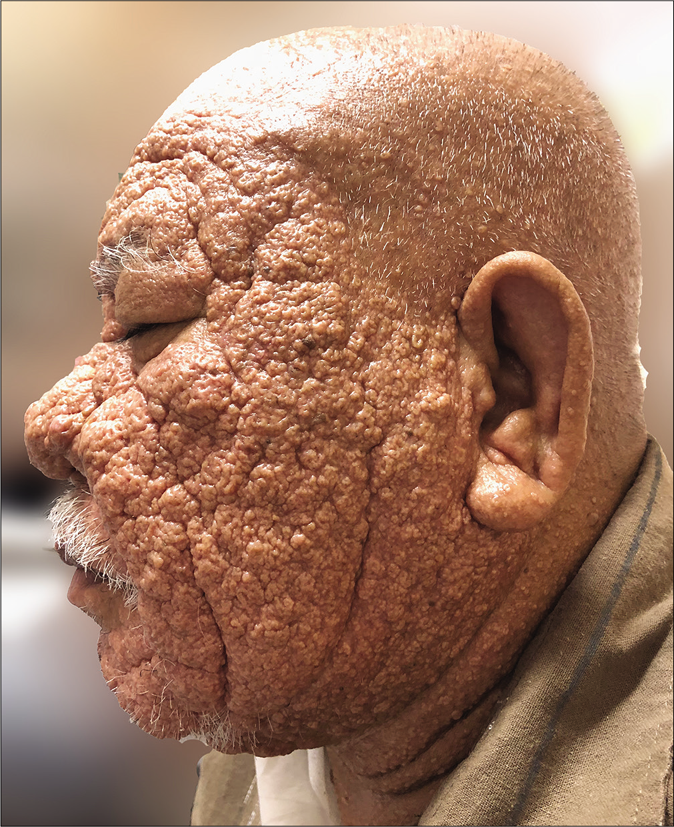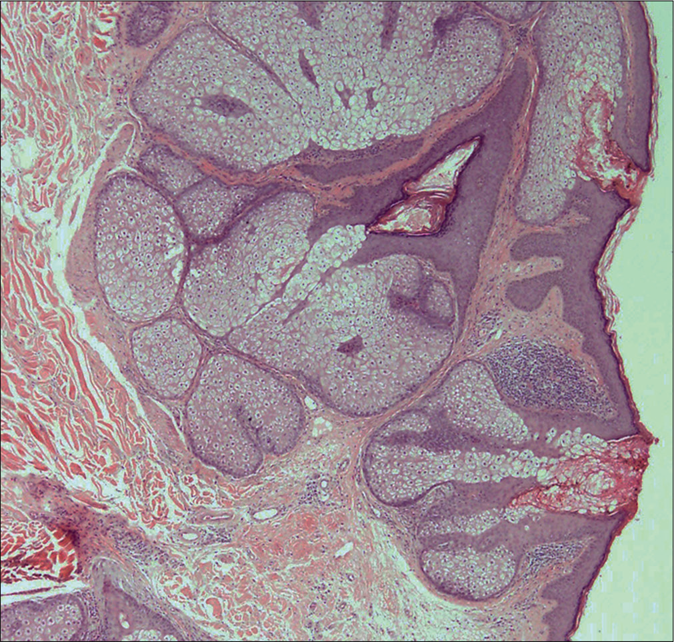Translate this page into:
Leonine facies
Corresponding author: Dr. Qin Jian Low, Department of Internal Medicine, Hospital Sultanah Nora Ismail, Taman Soga, 83000, Batu Pahat, Johor, Malaysia. E-mail: lowqinjian@moh.gov.my
-
Received: ,
Accepted: ,
How to cite this article: Low QJ, Cheo SW, Yap WY. Leonine facies. Indian J Dermatol Venereol Leprol 2021;87:589-91.
A 69-year-old gentleman reported progressive skin-colored eruptions on his face and upper chest since the age of 40. He was diagnosed with end stage renal failure 5 years ago but denies personal or family history of malignancies. There was no history of immunosuppressive drugs usage. He was the seventh among 10 siblings, of which 3 (2 males and 1 female) had similar skin disorder after the age of 35. He had six children of which two, a son and a daughter reported similar skin changes. Physical examination showed diffuse skin-colored, greasy, umblicated papules on his cheeks, forehead, chin, and neck. No comedones were present. These papules coalesced to form plaques, giving rise to leonine appearance [Figures 1 and 2]. His periorbital, perinasal, perioral and periauricular areas were spared. There was no telangiectasia associated with rosacea noted.

- Multiple diffuse, greasy, dome -shaped umblicated papules on his face sparing the periorificial and nasolabial areas

- Multiple diffuse, greasy, dome- shaped umblicated papules seen on his face

- Light microscopy showing lobules’ expansion of the sebaceous glands around a central duct. The stroma is loose with foci infiltration of mononuclear cells. Deep dermis is unremarkable (H and E, ×40)
Question
What is your diagnosis?
Answer
Presenile diffuse familial sebaceous hyperplasia.
Skin biopsy of a lesion on his right cheek revealed dilated pilosebaceous ducts with keratin plugs, consistent with sebaceous hyperplasia [Figure 2]. There was absence of granulomatous inflammation, mucin, fibroblast proliferation and fibrosis to suggest the other differential diagnosis. We diagnosed the patient as presenile diffuse familial sebaceous hyperplasia, as he fulfilled the Dupre criteria.1 In addition, the autosomal dominant inheritance pattern, along with a negative history of exposure to immunosuppressants and onset of symptoms prior to his end--stage renal failure also supported this diagnosis.
Presenile diffuse familial sebaceous hyperplasia is a benign hereditary skin disorder which typically appears during adolescence and slowly progresses thereafter.2 The diffuse expanse of the sebaceous glands lead to irregular facial surfaces and excessive sebum production.3 In view of the extensive involvement in this case, isotretinoin was the preferred treatment of choice. It works by reducing the sebaceous gland size, diminishing proliferation of basal sebocytes, suppressing the production of sebum, and inhibits the differentiation of the sebocytes in vivo.4 Cauterization and excision may result in significant scarring and disfigurement. Lasers and photodynamic therapy are costly options, and are not available in our center. After 3 months of isotretinoin 20 mg daily, our patient showed significant improvement.
Acknowledgement
The authors gratefully acknowledge Dr. Haryati Binti Husin, consultant pathologist of the Department of Pathology of Hospital Pakar Sultanah Fatimah Muar for providing the histopathologic image and comment.
Declaration of patient consent
The authors certify that they have obtained all appropriate patient's consent forms. In the form, the patient has given his consent for his images and other clinical information to be reported in the journal. The patient understands that his name and initials will not be published and due efforts will be made to conceal identity, but anonymity cannot be guaranteed.
Financial support and sponsorship
Nil.
Conflicts of interest
The authors declare that there is no conflict of interest regarding the publication of this article.
References
- Familial presenile sebaceous gland hyperplasia. J Am Acad Dermatol. 1997;36:120-2.
- [CrossRef] [Google Scholar]
- Sebaceous hyperplasia: Systemic treatment with isotretinoin. An Bras Dermatol. 2015;90:211-5.
- [CrossRef] [PubMed] [Google Scholar]
- Premature familial sebaceous hyperplasia: Successful response to oral isotretinoin in three patients. J Am Acad Dermatol. 1997;37:996-8.
- [CrossRef] [Google Scholar]
- Oral retinoids in the treatment of seborrhoea and acne. Dermatology. 1998;196:140-7.
- [CrossRef] [PubMed] [Google Scholar]





